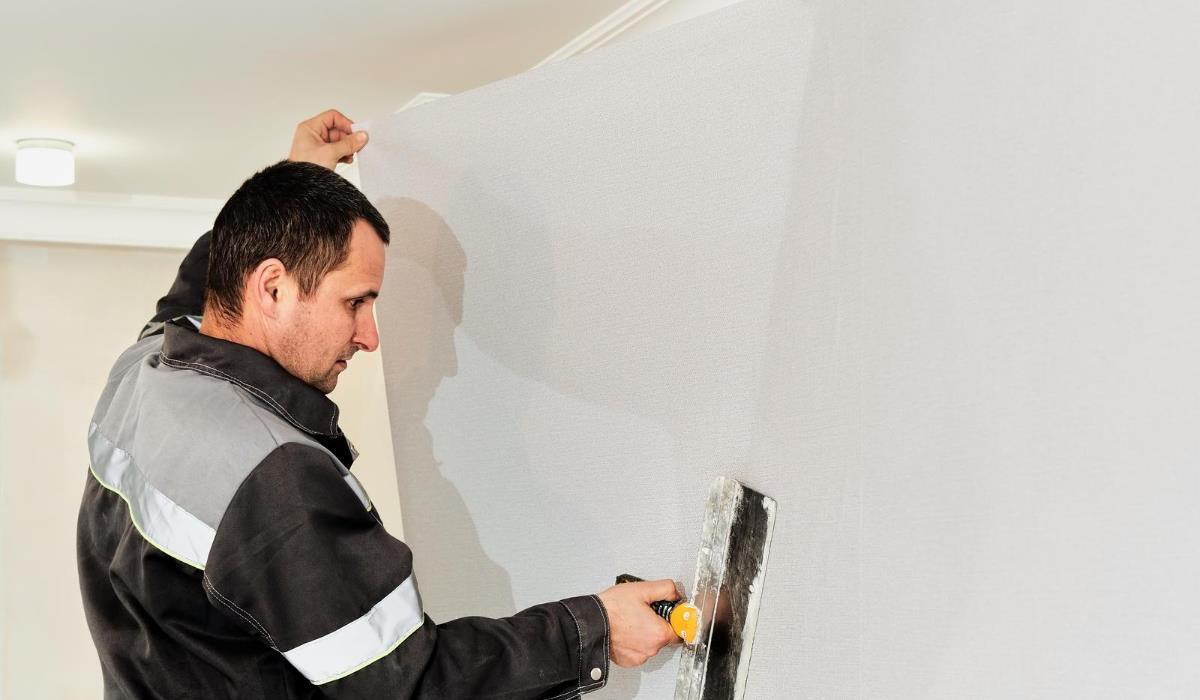Discovering how to wallpaper a decorative wall can bring a new dimension to a room. This is the perfect time to introduce bold colors and large patterns – and save money doing the work yourself.
Knowledge of wallpapering allows you to quickly and relatively inexpensively renovate a dining room, living room or bedroom. However, there are several decisions to be made before proceeding with the task. Which wall to choose as a decorative wall? How much wallpaper will be needed? How easy is it for a DIYer?
How much wallpaper do you need to wallpaper a decorative wall?
It depends on the surface that the decorative wall is to cover. Regardless of its size, however, you need to make sure you have enough wallpaper to match the pattern and complete the job. Therefore, it is important to correctly calculate the amount of wallpaper you need. Most ornamental walls will consist of two measurements to calculate the wall area: height multiplied by width.
How to wallpaper a decorative wall?
Before you start, make sure you have all the necessary tools, including a gluing table, a glue applicator brush, a wallpaper brush, a bucket, and wallpaper glue.
Prepare a decorative wall

Removing old wallpaper is the first step, especially if it is old and worn. Once the walls are clean, you need to clean them and fill any cracks or holes with repair putty or a suitable filler. Use a stiff brush to remove any dust or debris and wash the wall with a sugar-based cleanser if necessary. Then fill in any cracks and holes, let dry, then sand the entire wall with 120/180 grit sandpaper. Finally, brush the wall again and vacuum the dust. If the decorative wall is made of new plaster, you need to prepare it before wallpapering. Check out our guide to wallpapering on new plaster for all the tips you need.
Mark the starting point
To begin with, you need to mark a straight plumb line with a pencil using a plumb line or a large spirit level. If you are using patterned wallpaper, it is best to mark a line in the center of the wall. Take a roll of wallpaper, place it vertically along the line and mark the wall where the other end of the roll is. Repeat this step until you reach the corner. If you get narrow strips of wallpaper in the corner of a decorative wall, place the center of the roll of wallpaper on the line and mark how it works in the corner. Choose the option that gives you the greatest wallpaper width at each corner.
Apply glue and wallpaper

Measure the wall and then the wallpaper. Add a few centimeters at the top and bottom. Then trim the wallpaper. Prepare wallpaper glue and apply it to the paper with a roller or brush. Depending on the wallpaper you are using, you may want to apply glue to the wall first. Place the wallpaper on top of the wall and smooth it with a wallpaper brush. Work from the inside out to get rid of air bubbles. Adjust the wallpaper to the place and make sure that the edge coincides with the vertical line.
Trim the wallpaper, repeat and finish
To finish, use the back of the wallpaper scissors to make a crease in the paper at the top and bottom, then cut along the crease for a perfect fit. Now take another roll and repeat the process, making sure the edges line up and the patterns match. Use a roller to smooth out the joints of the wallpaper in parallel. Finally, wipe off excess glue with a damp cloth. When you’re done, make sure you remove the wallpaper glue residue properly.
Where to start wallpapering a decorative wall?
If the decorative wall is a simple wall, it is best to start from the center. Measure where the center of the wall is and mark with a plumb line using a long spirit level and a pencil. If a decorative wall includes a fireplace – or if the fireplace is the focal point – there are a few additional tips you need to know to get a nice finish. Check out our fireplace wallpapering guide for all the professional tips and tricks to get the job done right.
How do I get a clean finish in the corners?

Wallpapering a decorative wall usually covers one wall in combination with walls painted in one color. To get a sharp and clean transition between the wall and the wallpaper, it is necessary to paint first. You don’t have to paint the entire wall – you can only paint in the corners where the walls meet the ceiling. If you have time, however, we recommend painting the entire wall. Start by painting the ceiling and use a 2-3 inch wide brush to paint a few inches on top of the wall. Apply paint from the ceiling to the top of the wall to create a paint application from the ceiling to the top of the wall. Apply the same principle to the vertical corner and baseboards. This creates a frame around the decorative wall. This means that when you cut the wallpaper, if there are small gaps, the wall behind the wallpaper will be the same color as the other walls.
Which wall to choose as a decorative wall?
It depends on personal preference, but remember that the decorative wall will become the focal point of the room – so don’t choose the wall that is least visible. To make an impression, you can make a decorative wall the first one you see when you enter the room. Another popular solution is the wall opposite the sitting area if the decorative wall is in the living room, or the wall with the fireplace. Decorative walls don’t have to be limited to a single wall. You can decorate opposite walls with the same wallpaper pattern to create a cozy interior.



